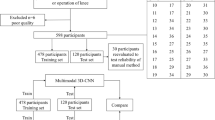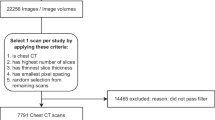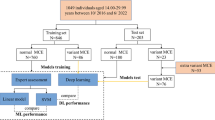Abstract
Objective
Adult age estimation (AAE) is a challenging task. Deep learning (DL) could be a supportive tool. This study aimed to develop DL models for AAE based on CT images and compare their performance to the manual visual scoring method.
Methods
Chest CT were reconstructed using volume rendering (VR) and maximum intensity projection (MIP) separately. Retrospective data of 2500 patients aged 20.00–69.99 years were obtained. The cohort was split into training (80%) and validation (20%) sets. Additional independent data from 200 patients were used as the test set and external validation set. Different modality DL models were developed accordingly. Comparisons were hierarchically performed by VR versus MIP, single-modality versus multi-modality, and DL versus manual method. Mean absolute error (MAE) was the primary parameter of comparison.
Results
A total of 2700 patients (mean age = 45.24 years ± 14.03 [SD]) were evaluated. Of single-modality models, MAEs yielded by VR were lower than MIP. Multi-modality models generally yielded lower MAEs than the optimal single-modality model. The best-performing multi-modality model obtained the lowest MAEs of 3.78 in males and 3.40 in females. On the test set, DL achieved MAEs of 3.78 in males and 3.92 in females, which were far better than the MAEs of 8.90 and 6.42 respectively, for the manual method. For the external validation, MAEs were 6.05 in males and 6.68 in females for DL, and 6.93 and 8.28 for the manual method.
Conclusions
DL demonstrated better performance than the manual method in AAE based on CT reconstruction of the costal cartilage.
Clinical relevance statement
Aging leads to diseases, functional performance deterioration, and both physical and physiological damage over time. Accurate AAE may aid in diagnosing the personalization of aging processes.
Key Points
• VR-based DL models outperformed MIP-based models with lower MAEs and higher R2 values.
• All multi-modality DL models showed better performance than single-modality models in adult age estimation.
• DL models achieved a better performance than expert assessments.





Similar content being viewed by others
Abbreviations
- AAE:
-
Adult age estimation
- CNNs:
-
Convolutional neural networks
- DL:
-
Deep learning
- MAE:
-
Mean absolute error
- MIP:
-
Maximum intensity projection
- ROI:
-
Region of interest
- VR:
-
Volume rendering
References
Schmeling A, Dettmeyer R, Rudolf E, Vieth V, Geserick G (2016) Forensic age estimation. Dtsch Arztebl Int 113:44–50
Fan F, Tu M, Li R et al (2020) Age estimation by multidetector computed tomography of cranial sutures in Chinese male adults. Am J Phys Anthropol 171:550–558
Štern D, Payer C, Urschler M (2019) Automated age estimation from MRI volumes of the hand. Med Image Anal 58:101538
Suciyanie IM, Gultom FP, Hidayat AN, Suhartono AW, Yuniastuti M, Auerkari EI (2022) Accuracy of forensic age estimation using cementum annulation and dentin translucency in adult: a systematic review and meta-analysis. Int J Legal Med 136:1443–1455
Cheng J, Liu Z, Guan H et al (2021) Brain age estimation from MRI using cascade networks with ranking loss. IEEE Trans Med Imaging 40:3400–3412
Gualdi-Russo E, Saguto I, Frisoni P, Neri M, Mongillo J, Rinaldo N (2022) Age estimation using tooth cementum annulations: bias and sources of inaccuracy. Front Biosci (Landmark Ed) 27:141
San-Millán M, Rissech C, Turbón D (2017) New approach to age estimation of male and female adult skeletons based on the morphological characteristics of the acetabulum. Int J Legal Med 131:501–525
Kazmi S, Mânica S, Revie G, Shepherd S, Hector M (2019) Age estimation using canine pulp volumes in adults: a CBCT image analysis. Int J Legal Med 133:1967–1976
Karydi C, García-Donas JG, Tsiminikaki K, Bonicelli A, Moraitis K, Kranioti EF (2022) Estimation of age-at-death using cortical bone histomorphometry of the rib and femur: validation study on a British population. Biology 11(11):1615
Zhang K, Fan F, Tu M et al (2018) The role of multislice computed tomography of the costal cartilage in adult age estimation. Int J Legal Med 132:791–798
Mavroudas SR, Meckel LA, Gocha TP, Goldstein JZ, Garza SL (2022) The effects of experimental whole-body burning on histological age-at-death estimation from human cortical bone and dental cementum. Biology 11(11):1569
Nam JG, Kang HR, Lee SM et al (2022) Deep learning prediction of survival in patients with chronic obstructive pulmonary disease using chest radiographs. Radiology 305:199–208
Yang CY, Pan YJ, Chou Y et al (2021) Using deep neural networks for predicting age and sex in healthy adult chest radiographs. J Clin Med 10(19):4431
Arunmozhi S, Rajinikanth V, Rajakumar MP (2021) Deep-learning based automated detection of pneumonia in chest radiographs 2021 International Conference on System, Computation, Automation and Networking (ICSCAN), pp 1–4
Zhang K, Liu X, Xu J et al (2021) Deep-learning models for the detection and incidence prediction of chronic kidney disease and type 2 diabetes from retinal fundus images. Nat Biomed Eng 5:533–545
Raghu VK, Weiss J, Hoffmann U, Aerts H, Lu MT (2021) Deep learning to estimate biological age from chest radiographs. JACC Cardiovasc Imaging 14:2226–2236
He K, Zhang X, Ren S, Sun J (2016) Deep residual learning for image recognition. Proceedings of the IEEE conference on computer vision and pattern recognition, pp 770–778
Xie S, Girshick R, Dollár P, Tu Z, He K (2017) Aggregated residual transformations for deep neural networksProceedings of the IEEE conference on computer vision and pattern recognition, pp 1492–1500
Huang G, Liu Z, Van Der Maaten L, Weinberger KQ (2017) Densely connected convolutional networks Proceedings of the IEEE conference on computer vision and pattern recognition, pp 4700–4708
SzegedyC L (2015) Goingdeeperwithconvolutions//ProceedingsoftheIEEEConferenceonComputerVision andPatternRecognition. Boston, USA 1:9
Luo Y, Zhang Y, Yan J, Liu W (2021) Generalizing face forgery detection with high-frequency features Proceedings of the IEEE/CVF conference on computer vision and pattern recognition, pp 16317–16326
Wang Y, Huang W, Sun F, Xu T, Rong Y, Huang J (2020) Deep multimodal fusion by channel exchanging. Adv Neural Inf Process Syst 33:4835–4845
Hu J, Shen L, Sun G (2018) Squeeze-and-excitation networks Proceedings of the IEEE conference on computer vision and pattern recognition, pp 7132–7141
Woo S, Park J, Lee J-Y, Kweon IS (2018) Cbam: convolutional block attention module Proceedings of the European conference on computer vision (ECCV), pp 3–19
Park J, Woo S, Lee J-Y, Kweon IS (2018) Bam: bottleneck attention module. https://doi.org/10.48550/arXiv.1807.06514. Accessed 22 May 2023
Nummela MT, Bensch FV, Pyhältö TT, Koskinen SK (2018) Incidence and imaging findings of costal cartilage fractures in patients with blunt chest trauma: a retrospective review of 1461 consecutive whole-body CT examinations for trauma. Radiology 286:696–704
Bonicelli A, Zioupos P, Arnold E, Rogers KD, Xhemali B, Kranioti EF (2021) Age related changes of rib cortical bone matrix and the application to forensic age-at-death estimation. Sci Rep 11:2086
Bonicelli A, Xhemali B, Kranioti EF, Zioupos P (2017) Rib biomechanical properties exhibit diagnostic potential for accurate ageing in forensic investigations. PLoS One 12:e0176785
Milenkovic P, Djuric M, Milovanovic P, Djukic K, Zivkovic V, Nikolic S (2014) The role of CT analyses of the sternal end of the clavicle and the first costal cartilage in age estimation. Int J Legal Med 128:825–839
Michelson N (1934) The calcification of the first costal cartilage among whites and negroes. Human Biol 6:543
Garamendi PM, Landa MI, Botella MC, Alemán I (2011) Forensic age estimation on digital X-ray images: medial epiphyses of the clavicle and first rib ossification in relation to chronological age. J Forensic Sci 56(Suppl 1):S3–S12
Moskovitch G, Dedouit F, Braga J, Rougé D, Rousseau H, Telmon N (2010) Multislice computed tomography of the first rib: a useful technique for bone age assessment. J Forensic Sci 55:865–870
Ashiqur Rahman S, Giacobbi P, Pyles L, Mullett C, Doretto G, Adjeroh DA (2021) Deep learning for biological age estimation. Brief Bioinform 22:1767–1781
Jiang Y, Yang M, Wang S, Li X, Sun Y (2020) Emerging role of deep learning-based artificial intelligence in tumor pathology. Cancer Commun (Lond) 40:154–166
Wainberg M, Merico D, Delong A, Frey BJ (2018) Deep learning in biomedicine. Nat Biotechnol 36:829–838
González G, Ash SY, Vegas-Sánchez-Ferrero G et al (2018) Disease staging and prognosis in smokers using deep learning in chest computed tomography. Am J Respir Crit Care Med 197:193–203
Shi W, Yan G, Li Y et al (2020) Fetal brain age estimation and anomaly detection using attention-based deep ensembles with uncertainty. Neuroimage 223:117316
Stahlschmidt SR, Ulfenborg B, Synnergren J (2022) Multimodal deep learning for biomedical data fusion: a review. Brief Bioinform 23(2):bbab569. https://doi.org/10.1093/bib/bbab569
Pan Y, Liu M, Xia Y, Shen D (2022) Disease-image-specific learning for diagnosis-oriented neuroimage synthesis with incomplete multi-modality data. IEEE Trans Pattern Anal Mach Intell 44:6839–6853
Kang L, Jiang J, Huang J, Zhang T (2020) Identifying early mild cognitive impairment by multi-modality MRI-based deep learning. Front Aging Neurosci 12:206
Acknowledgements
We would like to thank the excellent professional support of our radiologists and computer experts. Besides, we thank our colleagues for their valuable insights and expertise that contributed to our research and professional assistance in the writing of the manuscript.
Funding
This study was funded by the National Natural Science Foundation of China (No. 81971801) and the Open Fund Project of Shanghai Key Lab of Forensic Medicine and Key Lab of Forensic Science (No. KF202209).
Author information
Authors and Affiliations
Corresponding authors
Ethics declarations
Guarantor
The scientific guarantor of this publication is Zhen-hua Deng, a Professor and the West China School of Basic Medical Sciences and Forensic Medicine, Sichuan University, Chengdu 610041, PR China. Email: dengzhenhua@scu.edu.cn.
Conflict of interest
The authors of this manuscript declare no relationships with any companies whose products or services may be related to the subject matter of the article.
Statistics and biometry
One of the authors has significant statistical expertise.
Informed consent
Written informed consent was waived by the Institutional Review Board.
Ethical approval
Institutional Review Board approval was obtained.
Study subjects or cohorts overlap
None.
Methodology
• Retrospective
• Observational study
• Performed at one institution
Additional information
Publisher's Note
Springer Nature remains neutral with regard to jurisdictional claims in published maps and institutional affiliations.
Supplementary Information
Below is the link to the electronic supplementary material.
Rights and permissions
Springer Nature or its licensor (e.g. a society or other partner) holds exclusive rights to this article under a publishing agreement with the author(s) or other rightsholder(s); author self-archiving of the accepted manuscript version of this article is solely governed by the terms of such publishing agreement and applicable law.
About this article
Cite this article
Lu, T., Diao, Yr., Tang, Xe. et al. Deep learning enables automatic adult age estimation based on CT reconstruction images of the costal cartilage. Eur Radiol 33, 7519–7529 (2023). https://doi.org/10.1007/s00330-023-09761-3
Received:
Revised:
Accepted:
Published:
Issue Date:
DOI: https://doi.org/10.1007/s00330-023-09761-3




